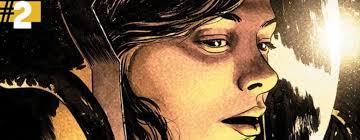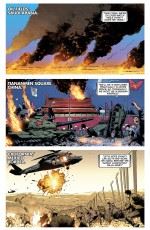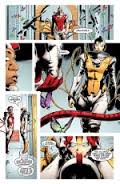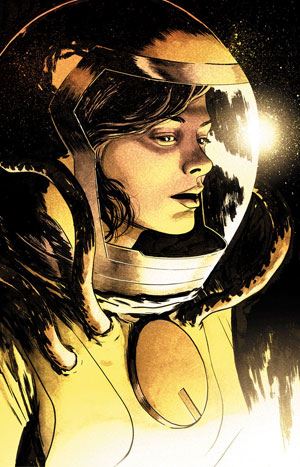Comics /
Comic Reviews /
More Comics
Review: Divinity II: Book 2

By Beth Davies-Stofka
June 16, 2016 - 12:37
Book 2 of the second installment in Valiant’s Divinity comic book series portrays painful scenes of single-minded cruelty while suggesting that there are even more fearsome things to come. Yet somehow, hope makes its presence known. In Divinity II: Book 2, writer Matt Kindt, artist Trevor Hairsine, inker Ryan Winn, and colorist David Baron, explore some of the darker sides of the human condition, including egoism, vengeance, blind patriotism, social engineering, murderous intent, and major abandonment issues. You’ll be hooked, even if this is the first book you read in the series. And that’s even before you see the cliffhanger on the final page!
What’s Happening: In the first mini-series, Divinity I, we learned that during the Cold War, the Soviet Union gambled heavily with the life of cosmonaut Abram Adams. They sent him on a mission further into space that anyone had been before. There, Adams met something Unknown. The encounter gave him the ability to bend space, matter, and even time, to his will. In short, he became “Divinity.” When he returned to Earth he frightened the powers that be, so much so that he was imprisoned by MI-6, with the cooperation of the other western powers.
In this second series, Divinity II, we learn that Abram did not fly a solo mission. In fact, he had two co-pilots. Like him, they were orphans. One of them has now returned, a woman named Mishka. Mishka grew up on the streets of Moscow, hardened by her experiences, but singularly loyal to the Soviet Union. As a result, she is is horrified by the new Russia, which is nothing like the one she left behind. She wants things back to the way they were. In one month, she has pushed Russia to become the top superpower, shocking the rest of the world. Angry, abandoned, betrayed, and tyrannical, Mishka also has the powers of the Unknown. She is very dangerous. She is Divinity II.
The Writing: Divinity II asks the ideal follow-up question to Divinity I. What if there really is someone out there who is as threatening as Adams was perceived to be?
 |
| Divinity II Book 2, Artist: Trevor Hairsine |
Maybe it’s a cop-out to make the threat emanate from Russia. The Eastern Hemisphere has provided many a stereotypical comic book villain. Still, the Russian setting, currently fraught (in the real world) with overt contradictions and hidden uncertainties, is loaded with possibilities. Even more interesting, writer Matt Kindt is exploring the recent and bifurcated past of an emerging global society. The perspective of the comic is not that of “east vs. west,” but of whether, or when, that old paradigm can finally be left behind.
The new Divinity is interesting too; or at least, she is intense. The symbolic meaning of Abram Adams’ name was layered with possibility. In contrast, Mishka (the Russian bear) is a superficially efficient symbol, signaling her single-minded commitment to the old Soviet regime.
Mishka is mysterious in her plan, but not in her intent: to restore the USSR to its former glory. This allows Kindt to introduce a number of intriguing themes. Mishka has apparently limitless powers, but she also has tunnel vision. What is the USSR's “former glory,” in her view? What does she want? What will she do to get her way? Will there be a new Cold War, or even a third World War?
How does her plan connect to WWII, that pivotal moment in history from which the Cold War emerged? How do Mishka's ambitions align with those of Joseph Stalin, Russian dictator, and perhaps the most accomplished mass murderer of the 20th century?
Miskha’s absolutist ideology, her seemingly divine powers, and her loyalty to the former Soviet Union also raise a question which we have not had occasion to ponder for some years. Is Communism a religion?
As if this isn’t a long enough list of provocative questions, the pain of abandonment hovers over the whole story. This is the pain that defines Mishka’s relationship with Adams. It is perhaps the deepest and most intractable question of all. These three cosmonauts were orphans.
Adams’ motives were trustworthy and pure, because they lay with protecting the family he kept hidden. But Mishka has no family. She only has the nation-state, which lacks all the concrete specificity of relationship. A nation-state is an idea, and an unstable human being working to enact an idea can cause all kinds of terror. What if you gave that unstable person powers approaching those of God? This is a good setup, and this story has a lot of promise.
The Artwork: The artwork offers the comfortable familiarity of virtually every other current superhero comic book. It is exciting and action-packed, and uses color to excellent effect when communicating mood. The most outstanding art is found in the (spoiler alert!) fight between Adams and Mishka, which takes up 7+ of the 23 pages and takes the reader on a dizzying ride to the center of the earth, and then to the end of the universe.
 |
| Divinity II Book 2, Artist: Trevor Hairsine |
The action is emotional, and it is visceral. Much of this has to do with the framing, which keeps the eyes moving with the action, and the colors, which intensify the impact. The fighters are always in the foreground. Foregrounding forces a reader's deeper immersion in the conflict, so that when it seems all is lost, you can’t believe it. So you don’t.
The hat tip to formal conventions of film noir villainy at the end says everything, without having to say anything. It’s comic art bliss when image, word, sound, and meaning all work inextricably to generate one coherent experience. This book does that, so while I don’t find the art especially unique, I do find it especially effective.
As a bonus, the comic comes with five pages of commentary by colorist David Baron. I love this. This comic was a page-turner, no doubt about it, but Baron’s commentary was my favorite part. I love a good peek behind the scenes of creating a comic, and I love learning to appreciate comic art from the perspective of an expert practitioner. Not only that, but Baron’s enthusiasm for the book and for his colleagues is infectious.
The Verdict: In the press release announcing the new series, Valiant CEO & Chief Creative Officer Dinesh Shamdasani said, ”DIVINITY was a true force of nature in 2015. With a seemingly insatiable demand from fans and retailers, it's racked up 11 red-hot printings, a slew of 'best of' awards, and astronomical back-issue prices. This has been a true runaway hit in every sense of the term.” For Divinity II, Valiant reassembled the original creative team: writer Matt Kindt, artist Trevor Hairsine, inker Ryan Winn, and colorist David Baron.
Shamdasani also said that Divinity was always meant to be told in two parts. Let’s hope it’s three. There’s a third cosmonaut out there, and even if ze shows up in this series, it would be great to anticipate Divinity III.
Divinity II is provocative, exciting, and action-packed. The themes of patriotism, abandonment, and evil, the return to the Cold War, and a promise of some time-altering badness, are all enticing in their own way. Take a look.
Rating: 8.5 /10
Last Updated: January 17, 2025 - 08:20



